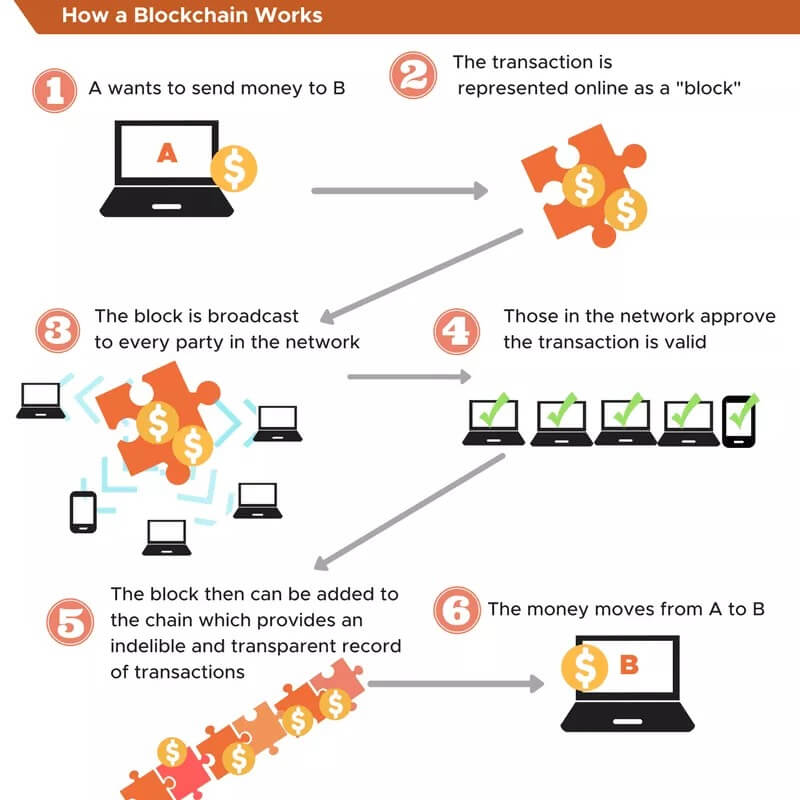What is Peer-to-Peer (P2P)?
In computer science, the definition of P2P, also known as a peer-to-peer network, is a decentralized network that comprises a group of devices (users) connected together to share and store information with each other. Each node or device acts as an individual server.
This means peer-to-peer communication is done in this network without any central server or administration, meaning all users are regarded in equal power and can perform identical tasks.
In blockchain technology, the definition of P2P usually refers to exchanging virtual assets or cryptocurrencies through a distributed network. In such a P2P network, buyers and sellers implement transactions without the need for go-betweens.
P2P internet connections can be ideal for various tasks, but they became prevalent in the mid-1990s when the first file-sharing program was created. Some of the regularly used file-sharing platforms include Gnutella and Napster.
At present, P2P platforms are at the foundation of most virtual currencies, making up a significant percentage of the blockchain industry.
A peer network is not confined to blockchain technology. They are also being incorporated into other distributed computing applications such as streaming platforms, InterPlanetary File System (IPFS) web protocol, web search engines, and online marketplaces.
Is P2P Illegal?
The legality of P2P depends on the definition and which term you are referring to. If you are inquiring about pay to play, there are no concrete laws to regulate the online practice. However, specific states in the United States have laid down policies to govern the adult industry, incorporating P2P.
On the other hand, sharing information, music, media, and work through a P2P network such as Napster and Gnutella are considered legal only if you are the copyright owner. However, any activity done on a file-sharing network or music-sharing application is termed illegal if you share or download copyrighted works without the publisher’s consent.
Is Uber a Peer-to-Peer?
Over the past few years, several firms such as Uber, Airbnb, and Lyft have found success utilizing peer-to-peer sharing systems. In return, the sharing economy continues to witness a drastic increase in popularity.
At present, Investopedia predicts peer-to-peer service providers are going to drive much of the sharing economy, with analysts projecting a market size of about 330 billion US dollars before 2025.
Since the service relies on internet connection, new internet service providers continue to emerge.
How do Peer-to-Peer networks work?
One peer network is essentially managed by a host of users who are connected together through a distributed network. Usually, P2P networking does not assume a central model or have an administrator. Each user holds a copy of the files, acting both as a server and as a client.
Therefore, each user can upload files to other computers and download files to them. This is the main attribute that makes P2P internet connections stand out from other conventional client-server networks.
In conventional client-server networks, peers download files and documents from a centralized server.
On the other hand, a P2P network shares files and documents stored on their computer system. This is made possible with the assistance of software applications tailor-made to act as intermediaries between users connected over the internet.
Once users download a specific document, they are given the privilege to act as an administrator of that document.
Put in another way; when a computer acts as a client, they can only download files from other client computer systems. But when a computer has a particular file of interest, they become the source and work as a server from which other computer systems download the file.
In essence, both functions of uploading and downloading can be implemented at the same time. And since every client computer stores, receive, and transmits files, peer to peer networks tend to be more efficient and faster as their user base grows larger.
Additionally, peer P2P internet connections tend to be more resistant to cybercrime and attacks thanks to their distributed network architecture. Unlike conventional systems, peer P2P does not have a distinct point of failure.
At present, there are 3 main types of peer-to-peer systems that are categorized according to their architecture. They are hybrid P2P, structured, and unstructured internet connections.
Hybrid P2P Networks
Hybrid peer to peer computers brings together some aspects of peer network with the traditional client-server model.
When compared to the structured and unstructured models, hybrid computers tend to offer an overall improved performance. This is because it combines the advantages of structured and unstructured platforms to provide and achieve significant degrees of competence and decentralization concurrently.
Structured P2P Networks
Adjacently, a structured peer-to-peer system offers an organized architecture that allows peers to search for files in the network efficiently, even when the content is not widely available. More often than not, this is achieved by optimizing the hash function that enhances database lookups.
Although these computers offer more efficiency in their operations, they tend to ask for higher maintenance and setup costs while providing higher centralization levels. Apart from that, structured systems are less productive when faced with higher rates of churn.
Unstructured P2P Networks
As the name suggests, an unstructured P2P model does not operate in any specific organization. The users communicate randomly with one another without following any laid down procedure.
Unstructured P2P systems are considered reliable against high churn activity. While they are easy to set up, unstructured P2P systems and computers tend to require higher memory usage and CPU power, given that search queries are dispatched out to the highest number of hard disks possible.
This action tends to flood the system with requests, especially if a small number of hard disks offer the desired response.
The role of Peer-to-Peer in Blockchain
In the infancy stages of the leading cryptocurrency, Bitcoin, Satoshi Nakamoto described it as a P2P Electronic Cash System. Using blockchain technology, Bitcoin can be transferred from one person to another through a P2P network.
A peer-to-peer (P2P) service is a decentralized platform whereby two individuals interact directly with each other, without intermediation by a third party. The role of Blockchain technology is to act as a distributed ledger. The peer-to-peer architecture of blockchain allows all cryptocurrencies to be transferred worldwide, without the need of any middle-man or intermediaries, or central server.
Therefore, there are no record keeping or bank processing operations in the Bitcoin network. Alternatively, the blockchain P2P software acts as a virtual ledger that openly records all Bitcoin activities. Each user’s hard drive holds a copy of the blockchain and verifies it with peers’ hard drive to ensure the information is accurate. In case of any inaccuracy or malicious activity, the network quickly rejects the transaction.
Any user can convert their computer networks to be a Bitcoin validator if they wish to get involved in the process of validating and verifying transactions.

Role of computer systems in P2P networks
As you already know by now, P2P stands for peer-to-peer. And in P2P software, computer systems are regarded as peers and are interconnected to each other through the internet.
On a P2P software, music, games, and documents can be shared directly between computer systems without a central server’s need. In other words, each computing device on the peer-to-peer network becomes a standalone file server while maintaining its client status.
What are P2P payments?
Peer-to-peer payment services allow internet users to use their credit or debit card, bank account to pay family or friends from their phones or computers.
Also known as money transfer apps or P2P payments, peer-to-peer payment platforms such as PayPal, Venmo, Cash App allows users to send and receive money from their handheld devices through a linked bank account or card.
P2P payment systems come in handy when splitting the bill among family and friends.
Which P2P payment should you use?
In this day and age, paying a bill for your family and close friends should be an easy task. Making payments by computer or mobile phone was first commercialized by PayPal, Venmo, and Google. It is such P2P applications such as these that are revolutionizing how money transfer works.
At present, P2P applications have been incorporated by almost all credit unions, financial institutions, banks, and powerful social media platforms.
When it comes to which is the best P2P software you should use, it comes down to which program your family and friends already use. Having the same app as they make the exchange of money more convenient.
Are P2P networks safe for payments?
Most of the leading P2P payment service providers shield or encrypt your financial information to ensure your transactions are safe. However, there have been cases of hacks and scams on some applications.
How much and how fast are P2P payments?
When using a peer-to-peer payment program, it is essential to keep these things in mind.
- Be careful with the data entry. In the event, you mistype a receiver’s name, phone number, or email address, be informed the money will go to the wrong person, and you will not be able to retrieve your monies. Always double-check with each other before initiating a transaction.
- Transactions take time. Although you might get a transaction notification immediately, you might have to wait 2 or 3 business days to get the money. Some service providers are faster than others.
- You might incur a charge. You can generally implement a P2P payment from a P2P account or a linked bank account for free. However, some service providers charge a fee ranging from 2 percent to 3 percent.
Advantages of P2P architecture in Blockchain
The many benefits associated with the peer-to-peer model used in blockchain are endless. According to user experience, the most significant benefits is that peer to peer networks offer superior security than conventional client-server systems.
Unlike other networks, peer-to-peer networks associated with blockchain technology are practically immune to the Denial of Service (DoS) attacks.
Also, since most client hard drives are required to establish consensus with each other before a transaction is implemented, it is almost impossible to alter the original file.
Apart from security, user to user blockchain architecture also renders users immune to censorship by a central governing body. Unlike ordinary bank accounts, virtual currency wallets cannot be drained or frozen by banks or governments.
Limitations of P2P networks on Blockchain
The use of peer-to-peer networks on blockchain also comes with its fair share of limitations. Considering it is the norm for the distributed ledgers to be updated on every computer instead of a central server, massive CPU power is needed to implement transactions on a blockchain network.
While it offers increased security, reduced efficiency is one of the main limitations of this technology. Another hurdle we would like to shed light on is the hard fork events. Even though blockchain and cryptocurrency are secure, they are not 100 percent safe.
This means they are liable to hacking and other attacks that can modify them. In simpler terms, the hard fork event means anyone can duplicate the primary file, modify it according to their specifications, and create a new parallel network chain.
Despite the limitations, blockchain developers and operating system experts are still looking for ways to remove these barriers to make blockchain technology and cryptocurrency 100 percent safe and secure.
Conclusion
We cannot deny that P2P architecture is here with us. After all, it supports one of the most outstanding technologies of our time, blockchain technology.
Although P2P architecture can empower many other technologies such as energy trading platforms and file-sharing networks, it is currently being used to offer blockchain and cryptocurrency solutions.
P2P networking offer better decentralization, freedom, security, and immutability when paired with blockchain technology.
So, what are your thoughts about P2P systems and their role in cryptocurrency and blockchain technology? We would love to hear from you. Comment below and let us know.





